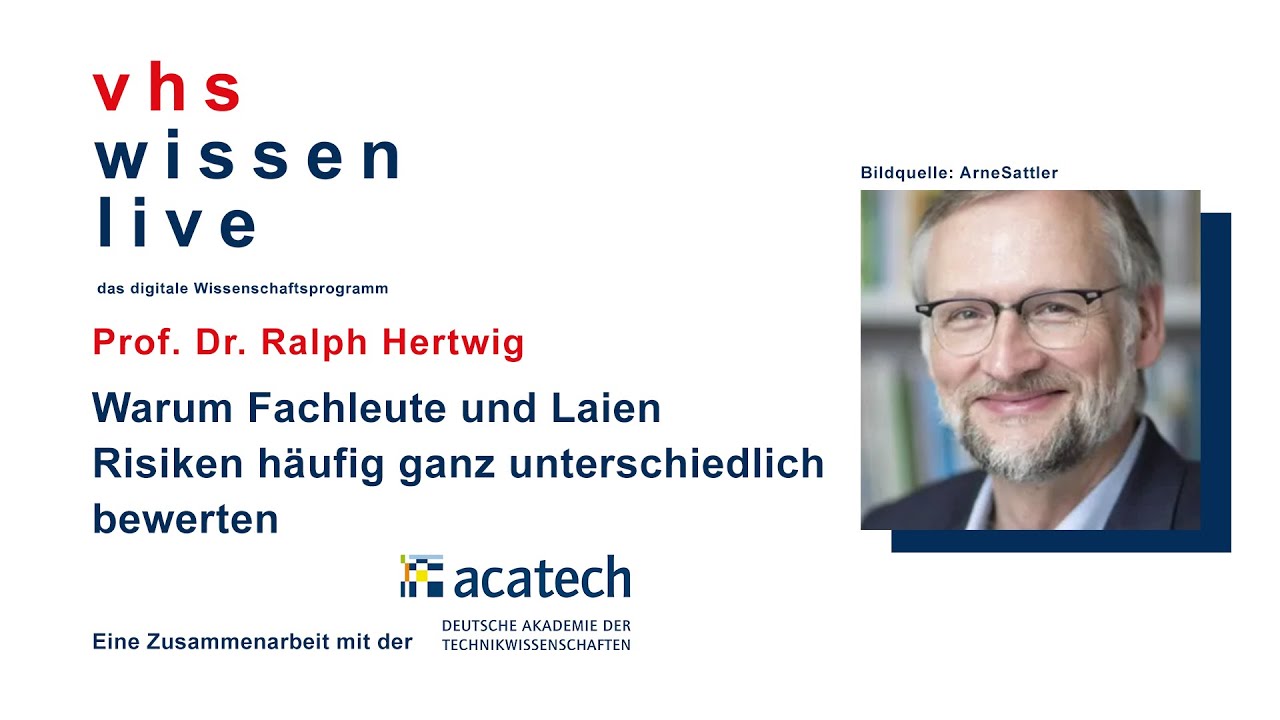Why experts and laypeople often assess risks very differently

Munich, 22 February 2024
In the event of technological risks, natural disasters or even a pandemic, experts and laypeople may assess risks completely differently. As a result, it is not uncommon for citizens to behave differently than experts recommend. acatech member Ralph Hertwig explained at acatech am Dienstag, which was held on 20 February in cooperation with vhs.wissen live and was attended by more than 600 viewers why opinions often differ and how this divide could be overcome.
In his welcome address, acatech President Jan Wörner discussed the various risks that people take every day as a matter of course – when they take part in road traffic, travel by train or do household chores. It is actually more likely to have a fatal accident at home (for example, falling off a ladder) than in an aeroplane crash. Nevertheless, most people are more afraid of flying than of climbing a ladder.
To the lecture (video in German) by Ralph Hertwig, Director of the Research Center for Adaptive Rationality and Managing Director of the Max Planck Institute for Human Development in Berlin.
Why experts and laypeople often assess risks very differently
Duration: 1 hour 08 minutes and 43 seconds
acatech member Ralph Hertwig, Director of the Research Center for Adaptive Rationality at the Max Planck Institute for Human Development in Berlin, used the example of the Vesuvius volcano to explain how carefree people are about real risks. Around three million people live in the immediate vicinity of the volcano in the greater Naples area and are constantly in great danger: scientists estimate that the probability of a major eruption is increasing from year to year. According to Ralph Hertwig, warnings from the Italian government and efforts by the authorities to relocate the population have so far had no effect.
Why do people live and work at the foot of Mount Vesuvius even though it is a ticking time bomb? What are the reasons for such a big difference in risk assessment between scientific experts and the population living there? Ralph Hertwig presented four possible hypotheses as to why perceptions here often diverge:
- Influence of disinformation and lack of trust in experts, state institutions and quality media.
- Socio-political factors such as social inequality
- Underlying dimensions of our risk perception
- The way we learn about risks
Influence of disinformation
According to Ralph Hertwig, trust in experts is also declining as the amount of false information we receive on a daily basis is increasing. Accordingly, scepticism towards information available in the media has increased and people are placing more trust in the people around them instead. For example, the Science Barometer 2023 shows that only 56 per cent of the German population still trust science, compared to 73 per cent in April 2020.
Social inequality and the perception of risk
In connection with socio-political factors, such as social inequality, Ralph Hertwig spoke about the so-called white male effect. This states that men are more willing to take risks. In addition, men apparently perceive risks differently – be it nuclear power, firearms, driving, illnesses. As a result, white men feel less threatened than women or black men, according to Ralph Hertwig. One explanation: while white men hold the levers of power and decide on the use of technologies or resources, women and ethnic minorities feel less powerful and therefore have a different perception of risks. What is the same for everyone, however, is that the willingness to take risks decreases with increasing age.
Dimensions of our risk perception
While a technical risk is understood as a product of the probability of damage and the extent of damage, psychological risk dimensions recognise catastrophic, unknown, chronic and known risks. According to Ralph Hertwig, the general public assesses unknown and catastrophic risks (such as nuclear power plants, genetic engineering or electromagnetic fields) as major risks. Accordingly, citizens want protection in this area, for example through state regulation. They categorise chronic and known risks (such as smoking, motorcycling and swimming pools) as minor risks.
What intervention options are there?
Finally, Ralph Hertwig explained various ways in which laypeople (which we all are in most areas) can arrive at a more accurate risk assessment. This includes reducing the frequency and influence of disinformation. Ralph Hertwig outlined a positive future for risk communication that is not only based on texts, but is also graphically convincing and ties in with people’s experiences. Fact boxes in a graphically appealing form can, for example, present the best available evidence on the potential benefits and harms of various medical interventions or health topics.
What were the questions asked by the audience?
The final discussion with the audience centred on the coronavirus pandemic, among other things: was risk perception excessively influenced by media portrayals, as was the case with swine flu a few years earlier? With regard to risk perception in different population groups, it was noted that parents could be more sensitive to risk for evolutionary reasons. More religious people could also arrive at different assessments of risks than non-religious people in certain areas relating to the conception of man and values (e.g. organ transplants). In addition, a closer examination of cultural factors that may cause the different perception of the risks of nuclear power plants was suggested. Finally, Ralph Hertwig discussed a current example: In the debate surrounding the risks of artificial intelligence, care must be taken to differentiate between fields of application, he said. A blanket condemnation of AI as a dangerous technology does not make sense.
Further information
Fundamental Questions in Science and Engineering Working Group
Harding Center for Risk Literacy: Fact Boxes
News: The risk paradox – perceived dangers and actual threats (in German)
Link to the book „Das Risikoparadox“ by Ortwin Renn (in German)




